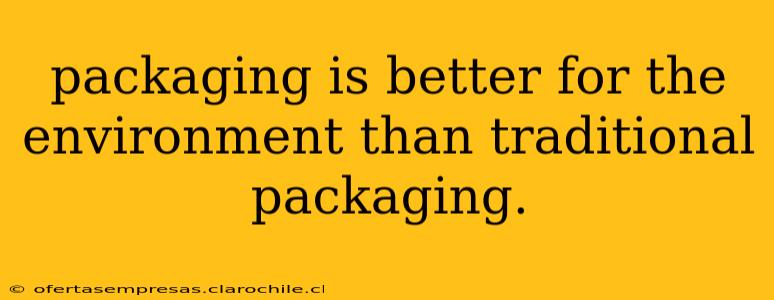The rise of eco-conscious consumers has fueled a surge in "eco-friendly" packaging options. But is this packaging truly better for the environment than traditional packaging materials? The answer, unfortunately, isn't a simple yes or no. It's far more nuanced and depends on several crucial factors. This article will delve into the complexities of sustainable packaging, exploring its benefits, drawbacks, and the critical questions we should ask before declaring any packaging definitively "better."
What Constitutes "Eco-Friendly" Packaging?
Before we compare, let's define what we mean by "eco-friendly" packaging. It typically encompasses materials and processes designed to minimize environmental impact throughout the product's lifecycle, from sourcing raw materials to disposal. This often includes:
- Biodegradable and Compostable Materials: Materials like cornstarch-based plastics, seaweed packaging, and mushroom packaging that break down naturally.
- Recycled Content: Utilizing recycled materials to reduce the demand for virgin resources.
- Reduced Packaging Weight: Minimizing material usage to lessen transportation costs and waste.
- Sustainable Sourcing: Ensuring materials are sourced responsibly, with minimal deforestation or harmful practices.
- Recyclable Materials: Packaging designed for easy recycling and participation in existing recycling streams.
How Does Eco-Friendly Packaging Compare to Traditional Packaging?
Traditional packaging, often made from materials like plastic (PET, PVC), polystyrene, and certain types of paper, frequently presents significant environmental challenges:
- Non-biodegradable Plastics: These persist in landfills for hundreds of years, contributing to plastic pollution.
- High Carbon Footprint: The production of traditional packaging materials often involves energy-intensive processes.
- Deforestation: Paper production can lead to deforestation if not sourced sustainably.
However, claiming all eco-friendly packaging is universally superior is misleading. The environmental impact depends on several factors:
What are the Drawbacks of Eco-Friendly Packaging?
While aiming for sustainability is commendable, certain "eco-friendly" options have their limitations:
- Higher Production Costs: Biodegradable or compostable materials can be more expensive to produce than conventional alternatives.
- Limited Infrastructure: Lack of widespread composting facilities means that even compostable packaging might end up in landfills.
- Performance Limitations: Some eco-friendly materials may not provide the same level of protection or shelf life as traditional packaging. This can lead to increased food waste.
- "Greenwashing": Companies sometimes use misleading marketing to exaggerate the environmental benefits of their packaging.
Is Biodegradable Packaging Always Better?
H2: What are the different types of biodegradable packaging?
Several types exist, including those made from cornstarch, seaweed, and mushroom materials. Their biodegradability varies greatly depending on the specific composition and environmental conditions (temperature, moisture, microbial activity). Some may only biodegrade in industrial composting facilities, not home compost bins.
H2: How does compostable packaging compare to recyclable packaging?
Compostable packaging requires specialized facilities for proper breakdown, while recyclable packaging relies on existing recycling infrastructure. Both have their place; the best choice depends on the local infrastructure and the material's recyclability.
H2: Are there any downsides to using recycled materials in packaging?
While using recycled content is generally positive, there can be challenges. Recycled materials may sometimes have lower quality than virgin materials, potentially affecting packaging performance. The recycling process itself requires energy.
Choosing the "Best" Packaging: A Holistic Approach
Determining whether eco-friendly packaging is "better" requires a holistic life cycle assessment. This considers the environmental impact across all stages:
- Raw material extraction: The environmental cost of obtaining raw materials.
- Manufacturing: Energy use and emissions during production.
- Transportation: Fuel consumption and emissions related to shipping.
- Use and disposal: Waste generation and disposal methods.
Consumers and businesses need to evaluate each specific packaging type within this context, considering factors like the material's recyclability, compostability, and the availability of appropriate disposal facilities. Transparency and clear labeling from manufacturers are vital for informed consumer choices.
In conclusion, the quest for environmentally responsible packaging is ongoing. While many eco-friendly options exist, they are not a universally superior solution. A thoughtful, holistic approach considering the entire lifecycle and available infrastructure is essential for making truly sustainable packaging choices.
